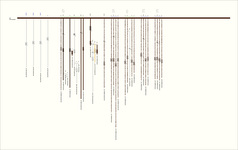| Statistics: |
Original Author: Marcia & Robert Ascher
Museum: Dartmouth College, Hanover, New Hampshire, Dartmouth College, Hanover, New Hampshire, USA
Museum Number: 55-32-13302
Provenance: Unknown
Region: Nazca
|
# of Cords: 37 (28p 9s)
# of Unique Cord Colors: 6
Benford Match: 0.8598
# Ascher Sums (pps, ips, cps, sps,...): 11 (6, 0, 3, 1,...)
Similar Khipu: Previous (AS004) Next (AS059)>
|
|
| Notes: |
Ascher Databook Notes:
- The museum records the provenance of the khipu as Nazca and its collector as J. Gayoso.
- U designates an undyed non-cotton fiber.
- Two pendant fragments (F1,F2) are stored with the khipu. By color and texture, they appear related to the khipu but there is no place that they seem to have come from. We think that they were part of the collection of the same khipumaker but not part of this khipu.
- By spacing and color the khipu is separated into three parts. Part I consists of four widely spaced pendants each W with a single figure-eight knot. Part II is a group of six pendants which differ in color but are united by a top cord. Part III consists of a single pendant and then four groups of four pendants each. All pendants in this part are color DB:W.
- Part II
- The value of the top cord on this khipu is the sum of the six pendant values in the group.
- The subsidiaries on the top cord probably sum the subsidiaries on the pendant cords but three values are in doubt due to breakage. The two W subsidiaries on the second pendant sum to at least 10 and another on the fourth pendant has value 2. A DB subsidiary on the third pendant has value 3 and an FB subsidiary on the fourth pendant is broken. These can be associated respectively with the following top cord subsidiaries: a W with value 13, a U with value 2, and a DB with value 4.
- Part III
- The four groups of four pendants each can be described as:
P3ij where i=(1,...,4) is the group and j=(1,...,4) is pendant position in group.
- The rank order of pendant values is the same for all groups. Also, in every group the first and third positions have value 1. That is:
11 ≥ P3i2 > P3i4 ≥ P3i3 = P3i1 = 1 for i=(1,...,4)
- P11, the pendant preceeding the four groups, has value 14 as does the sum of the first and third groups. That is,
- Parts II and III Related
- Parts II and III are set off from Part I by a large space along the main cord.
- The single group in Part II summarizes the values in Part III. Each of the pendant values in the group can be associated with a value or sum of values in Part III. Furthermore, the association involves all the values in Part III.
Calling the six pendant values in Part II P21j where j=(1,...,6):
- The top cord which sums the pendant values in Part II, therefore, also carries a value (76) that is the sum of all the values in Part III.
|













